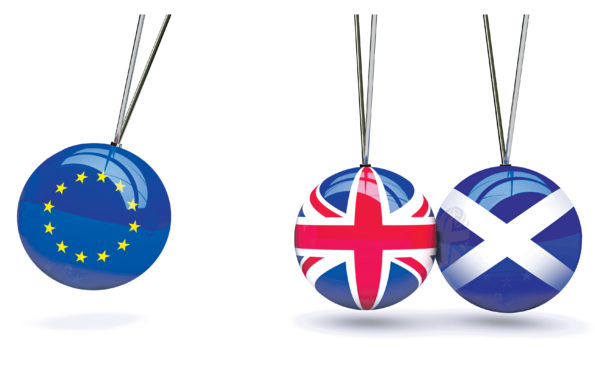
What’s at stake in this election are two unions – the UK’s relationship with the EU and the unity of the UK itself. And the two issues are intimately entangled.
During the 2016 referendum campaign, most Leavers and Remainers in the Home Counties seemed indifferent to the UK dimension. Hence the backstop blindspot. And all that was rooted in a deeper failure to appreciate how the UK had changed in the late-1990s.
When the UK’s Labour government instituted devolution referenda in 1997, Scotland and (less decisively) Wales voted in favour. Two years later devolved governments were inaugurated in Edinburgh and Cardiff.
By this time, intense efforts by John Major, Tony Blair and their civil servants to promote the peace process in Northern Ireland, working in tandem with Dublin, had culminated in the Good Friday Agreement of 1998.
What might be termed the de facto Millennium Settlement of 1998-89 developed a momentum of its own. The Scottish and Welsh governments gradually extracted more powers, particularly in Edinburgh, where the SNP was able to hold a full-scale referendum on independence in 2014.
Although this was defeated, the fact that almost 45% of voters wanted out represented a damning commentary on Scottish enthusiasm for the Union.
Across the Irish Sea, the peace process made Northern Ireland much more open to the Republic and, both there and in Scotland, Brussels made it easier to manage the new political geometry. UK membership of the EU generated valuable financial support for development and also smoothed potential friction points between the four constituent countries.
It’s worth remembering that historic border regions form roughly 40% of the EU’s total territory and embrace 30% of its population. A prime goal of the European project ever since the Treaty of Rome in 1957 has been to cleanse the continent’s ancient bloodlands.
So, a century on from the Home Rule crisis of 1914, it looked as if the UK was being redefined, with devolved governments in Scotland and Wales and transformed relations between Belfast, Dublin and London – all buttressed by shared membership of the EU.
Then the 2016 referendum threw everything into confusion. Although Wales, like England, voted to leave, 62% of voters in Scotland and 56% in Northern Ireland wanted to remain. And a “Future of England” survey in December 2018 indicated “the more English one feels, the more likely one is to express dissatisfaction with each of England’s two unions, one external, the other internal”.
In June, a poll of Tory members showed 63% were ready to bid farewell to Scotland, and 59% to Northern Ireland, if that was the price for severing ties with Brussels.
Because England includes nearly 85% of the UK population, English votes carried the day in 2016. Yet successful politics is not simply a numbers game. Leave won the referendum but the size of the Remain vote (48%) suggested the need to build political consensus, which both Theresa May and Boris Johnson have ignored – to their cost and ours.
Similarly, England carried the day within the UK but the fact that two other countries, each with its own distinctive heritage and needs, voted Remain pointed to the need for careful handing.
In October 2019, Johnson dumped the Democratic Unionists in Belfast in order to get a deal with Dublin and Brussels. This despite him having promised the DUP annual conference on November 24, 2018, that a customs border in the Irish Sea would leave Northern Ireland “an economic semi-colony of the EU” and “I have to tell you no British Conservative government could or should sign up to any such arrangement”.
In the current election campaign, Boris Johnson and Nicola Sturgeon are engaged in megaphone politics. The Prime Minister insists there will be no new Scottish independence referendum for a generation. The First Minister – who is campaigning for one in 2020 – has declared “all options” open if a Tory government blocks Scotland’s will.
But both these leaders are realists. Sturgeon wants a proper legal referendum, not Catalan-style chaos. And Johnson has been delicately described by columnist Simon Jenkins as a “pledge-breaking pragmatist” – as the DUP has recently learned. Depending on the post-election arithmetic, perhaps both leaders might contort themselves into agreeing another substantial devolution of powers and funding.
But what of the other union? Finding a way to assuage Scottish Remainers while “delivering Brexit” would be an even bigger stretch for Johnson. But that’s where pragmatic “pledge-breaking” might come in if he wins a working majority. After his betrayal of the DUP to create wriggle room over the Irish border, what’s to stop Johnson conjuring up some kind of flexibility over the EU’s single market in an effort to buy off Scotland? The ball would then be in the First Minister’s court.
After all, that’s the political beauty of simple but Delphic slogans like “Leave means Leave” and “Brexit means Brexit”. Ultimately, their meaning will be decided by a leader with real power. May’s weakness paralysed Westminster but Johnson and Sturgeon could shape the intertwined fate of two unions.
David Reynolds is the author of Island Stories: Britain and its History in the Age of Brexit, HarperCollins

Enjoy the convenience of having The Sunday Post delivered as a digital ePaper straight to your smartphone, tablet or computer.
Subscribe for only £5.49 a month and enjoy all the benefits of the printed paper as a digital replica.
Subscribe © DAVID HARTLEY/Shutterstock
© DAVID HARTLEY/Shutterstock